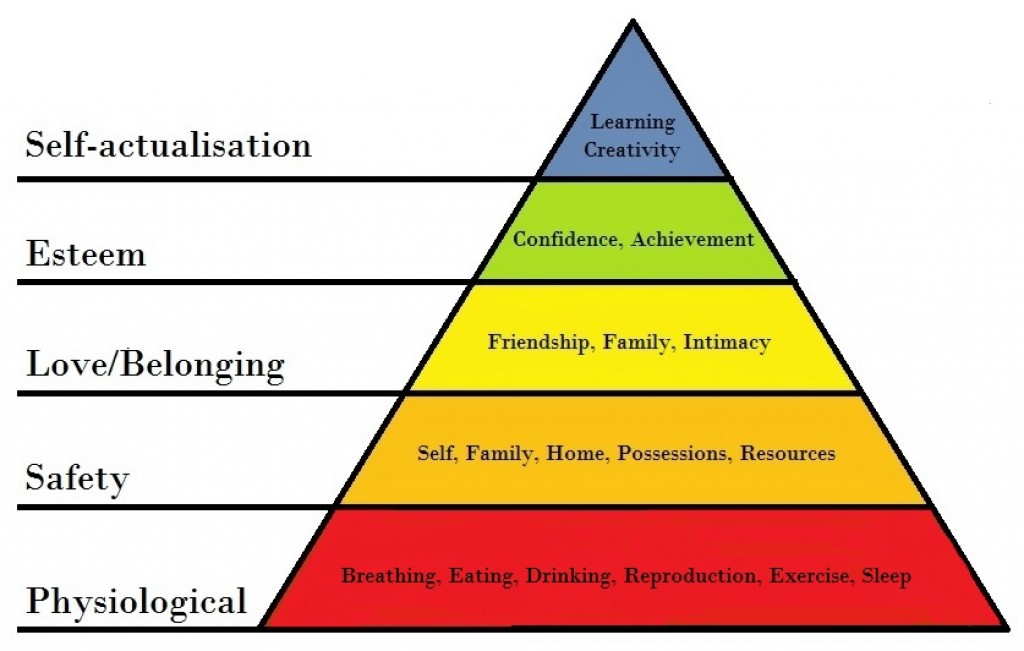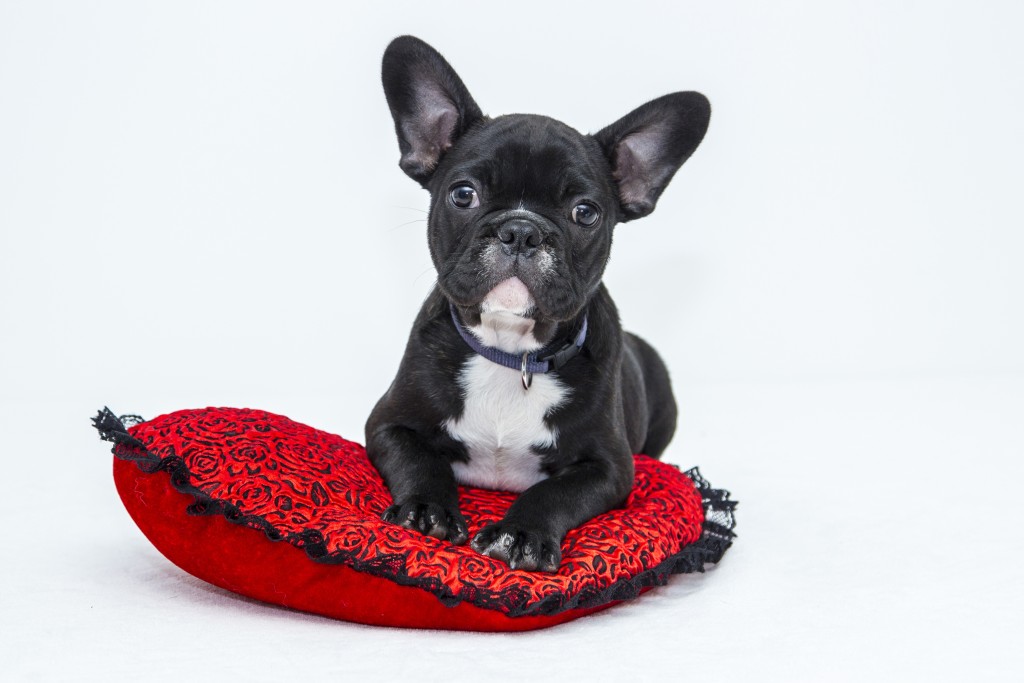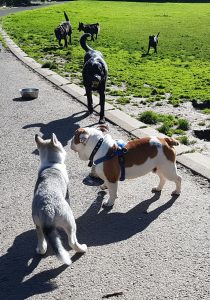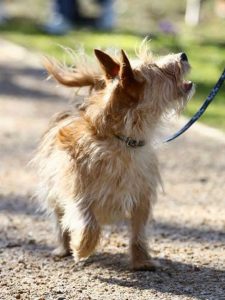Get an awesome recall. Join my 30 day, step by step program now...
Why does my dog… and how can I stop him?
Why does anyone do anything? The answer is simple really; we do what we do because it works. We do what we do because it makes us feel good; because on some level it has somehow satisfied a primal need that was present in us at that moment. If you are hungry; eating something will satisfy that need. If you are lonely; hugging a loved one might satisfy you. If you are afraid; it will make you feel better to create distance between you and your fear. It really is as simple as that.
We have lots of needs that ensure our survival in some way or another, and our pet dogs are no different. Psychologist Abraham Maslow’s research led him to identify our key motivators and in the 1940’s he first proposed his theory of the Hierarchy of Needs. Portrayed here as a pyramid, it is easy to see the basic motivators and the order in which they should be met for best survival. Of course, his pyramid refers to human needs, but I think it can safely be applied to dogs.
Hierarchy of Needs

In the pyramid, we can see that the most urgent needs are those of immediate survival – the physiological needs such as breathing, food and sleep. It is interesting to note that the most important layer of the pyramid also includes Reproduction and Exercise; two often neglected elements, especially in dogs. Only once all the needs are properly met on one level, can the dog seek to fully satisfy the next layer of the pyramid which is safety. Safety of self, family and possessions are included in this layer. As you can see, safety is less important than food, this is important as if this were not the case, the dog would not be able to put himself in a potentially dangerous position and hunt for his dinner.
How can I help you with your dogs behaviour training?
Private Dog Behaviour Consultations are currently available online and in-person in Dundee and the surrounding area. If you are looking for help solving your dogs behaviour and training problems, please get in touch!
If physiological needs are not met
Most problem behaviours can be included in this list. Here are a few of the more obvious ones.
| Unpredictable Behaviour | Poor Recall | Humping |
| Pulling on the Lead | House Soiling | Hyperactivity |
| Antisocial around Dogs | Barking | Destructive Behaviour |
| Jumping Up | Mouthing |
Physiological needs
Let’s talk in more detail about the needs on the bottom layer. Some of these are pretty obvious, we all know that we need to eat, sleep and breathe to stay alive. We would never even consider starving our furry buddy. But we should remember that not all food is created equal. To properly fulfil this need we need to consider whether we are offering him the best type of food, and in some cases whether we might be offering too much!
The Kennel Club, 2014
Fact: When surveyed, half of dog owners admitted to being embarrassed by their dogs behaviour in public!
I have already touched on the obvious needs. But many people don’t realise that it is just as important to get adequate exercise and to procreate. Yep, reproduction is that important. In fact, it might very well be the most important thing any of us can ever do. It will ensure the continuation of our family genes and the species – so no pressure!
Now we know how important procreation is for any animal or human, it is clear, that unless our pet dogs are allowed to partake in this activity regularly then, just like us, they will become unhappy and deeply frustrated. This could lead to unnatural and unsociable behaviour. The solution here is to do one of two things. Either find pooch a life partner, or take the problem away permanently and neuter your dog; I would personally recommend the second option, it is a far healthier and a much less risky option in the long run.
Does he need more exercise?
We should also take a moment to talk about exercise as it too features on the bottom level of the pyramid. This makes it an essential requirement for all dogs, and is very often neglected. In my experience, a lack of adequate exercise is often a contributing factor to behavioural problems. So it is worth considering whether you need to increase the amount of exercise Fido is getting, or if the intensity is right for him. Maybe he needs more doggy playtime, or a run alongside a bike, for example.
Safety needs
This second layer is mostly concerned with safety and security. Not just his own, but that of his family, the home, and the resources you all share too. Just like us, our dogs need to feel safe and, for most of us, we are all reassured when we are in the presence of someone who is calm and in control. We like rules and boundaries, and dogs are just the same.

The rule maker is also the one that is responsible for the main security, so your dog will thank you for relieving him of this burden. In order to properly satisfy your dogs safety needs, first create some rules and structure so that your dog knows exactly what is expected of him, and when. You must also learn to manage your own emotions when in the presence of your dog. Take your time, be patient, and especially be calm. A leader that loses his cool regularly will do nothing to make his pack feel safe and secure.
A secure den is a must. It will do his anxiety levels no good if there are regular, unexpected visitors to the garden. Especially if it is the neighbours dog. It is not just the garden you need to worry about. It is essential to make sure that visitors to your home are always properly invited in, and in a calm way, and not just allowed to come and go.
Problems caused by safety concerns
| Barking | Food Aggression | Poor Obedience |
| Scent Marking | Toy Aggression | Starving Himself |
| Aggression to Strangers | Demanding Behaviour | Jumping Up |
| Chewing | Begging |
Love and belonging
When it comes to our four legged friends, this is the one section that is rarely neglected. After all, we introduced a dog into our homes specifically so we could show them love and affection. For most of us, if we have worked hard to satisfy all the more urgent needs in the pyramid we should be getting tons of affection and loyalty back.
| Jumping Up | Attention Seeking | |
| Mouthing | Separation Crying | |
| Rough Play | Destructive Behaviour |
Don’t overdo it though. A dog that gets too much attention whenever he wants it, can become needy and dependent. This can lead to separation problems later. He may become overly attached to one or more members of his family too, and this could lead to him becoming overly protective of them. A good rule to follow, if you want to get this right is simply to make sure that love and affection is only offered as a reward to calm, gentle behaviour and is mostly only given by your demand and not your dogs.
Self actualisation and esteem
I have bunched these two together as they are not really that different, certainly not to dogs anyway. If you have managed to fulfil all your dogs desires up to this point, then your dog is ready to learn. This is important as he needs to feel like he can please you to be a useful member of your family. Taking time to teach your dog a few tricks will do wonders in this department. If you choose positive, reward based methods, it will be a great bonding experience for you both. You might even consider joining a local dog training club or taking up a sport together such as Flyball. A dog that doesn’t know how to please his family will quickly lose confidence in himself, and that could lead to any number of anxiety related behaviour problems.
| Poor Obedience | Antisocial with Dogs | |
| Fear of Strangers | Running Away | |
| House Soiling |

How can I change my dogs behaviour?
If you are struggling with your dogs behaviour and you want to change it, the answer is quite simple. Start at the bottom of the pyramid and work your way through each layer, making sure that you are meeting each need as you go. When you get to the top, you will have solved all the underlying problems. He might still be misbehaving, but your dog will now be ready to learn new behaviours and break his old habits. All that training will now finally start paying off.
If you are not sure how to stop a particular behaviour, a quick rule is to find out what you dog is hoping to get out of it and do the opposite. He’ll soon start looking for better ways to achieve the same result and when he picks one you approve of, just make sure you are ready to reward and encourage him.
You might also be interested in… Managing your dogs mood for rehabilitation.
Every dog is different
Just like you and me; your dog will need to have all his needs met at each level of the pyramid, starting at the bottom, before you can progress upwards. If you have missed any, you will struggle to effect any change in your dogs behaviour.
Remember also, that every dog is so completely different, some don’t need much input to satisfy their needs; a gentle cuddle and a friendly word might do the trick for some dogs, whereas others will need regular praise and contact to have their family and intimacy needs met. Likewise, some dogs are happy with a half hour amble round the park, whereas others will need two hours of free running and boisterous dog/dog play to be truly happy.
Be sure to judge your dog by his own standards and adjust his routine if you feel any one of his needs could use a little more attention, just make sure to be proactive and always meet them in a positive way.
Getting help
If you are not sure, it is always best to seek help from a local professional dog behavioural therapist. They will be able to identify the source of the behaviour problem, and show you how to fix it.
A cautionary word when choosing a behaviourist. Please make sure that their methods are kind and reward based. Always remember your pyramid. Any use of fear or force will conflict with his safety needs and will unbalance your dog. This can only cause new problems later on.
A good canine behaviourist will work privately with you in your own home. Your dog will be less distracted and will behave “normally” in his own environment. The trainer will get a better sense of him and the problems, and ultimately this means that they will be able to give you better advice.
Good luck!
How can I help you with your dogs behaviour training?
Private Dog Behaviour Consultations are currently available online and in-person in Dundee and the surrounding area. If you are looking for help solving your dogs behaviour and training problems, please get in touch!
How can I help you with your dogs behaviour training?
Private Dog Behaviour Consultations are currently available online and in-person in Dundee and the surrounding area. If you are looking for help solving your dogs behaviour and training problems, please get in touch!


